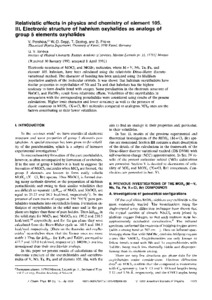| dc.date.accessioned | 2008-08-06T13:23:30Z | |
| dc.date.available | 2008-08-06T13:23:30Z | |
| dc.date.issued | 1992 | |
| dc.identifier.issn | 0021-9606 | |
| dc.identifier.uri | urn:nbn:de:hebis:34-2008080623115 | |
| dc.identifier.uri | http://hdl.handle.net/123456789/2008080623115 | |
| dc.format.extent | 836552 bytes | |
| dc.format.mimetype | application/pdf | |
| dc.language.iso | eng | |
| dc.publisher | American Institute of Physics | eng |
| dc.rights | Urheberrechtlich geschützt | |
| dc.rights.uri | https://rightsstatements.org/page/InC/1.0/ | |
| dc.subject.ddc | 530 | |
| dc.title | Relativistic effects in physics and chemistry of element 105. [Part] III. | eng |
| dc.type | Aufsatz | |
| dcterms.abstract | Electronic structures of MOCl_3 and MOBr_3 molecules, where M = V, Nb, Ta, Pa, and element 105, hahnium, have been calculated using the relativistic Dirac-Slater discrete variational method. The character of bonding has been analyzed using the Mulliken population analysis of the molecular orbitals. It was shown that hahnium oxytrihalides have similar properties to oxytrihalides of Nb and Ta and that hahnium has the highest tendency to form double bond with oxygen. Some peculiarities in the electronic structure of HaOCl_3 and HaOBr_3 result from relativistic effects. Volatilities of the oxytrihalides in comparison with the corresponding pentahalides were considered using results of the present calculations. Higher ionic character and lower covalency as well as the presence of dipole moments in MOX_3 (X = Cl, Br) molecules compared to analogous MX_5 ones are the factors contributing to their lower volatilities. | eng |
| dcterms.accessRights | open access | |
| dcterms.alternative | Electronic structure of hahnium oxyhalides as analogs of group 5 elements oxyhalides | eng |
| dcterms.bibliographicCitation | In: Journal of chemical physics. Melville NY : AIP. 97 (1992), Nr. 2, S. 1123-1131 | |
| dcterms.creator | Pershina, Valerija G. | |
| dcterms.creator | Sepp, Wolf-Dieter | |
| dcterms.creator | Bastug, Turgut | |
| dcterms.creator | Fricke, Burkhard | |
| dcterms.creator | Ionova, Galina V. | |

